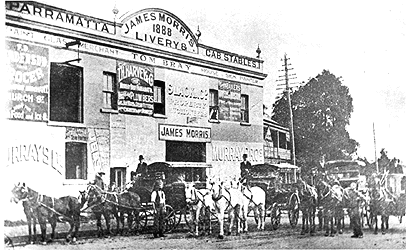BLACKSMITHS,
WHEELWRIGHTS & WAGGON CONSTRUCTION
 Blacksmiths & wheelwrights performed
an essential role in the colony. They created and mended a wide range of agricultural
implements, built ploughs, carts and made & shoed horses. Wheelwrights
built wheels and later did tyring for a wide range of vehicles. The majority
of towns in Western & South Western Sydney had at least one blacksmith & wheelwright
operating in the area. Wagons, coaches and buggies were often built locally.
The construction of wagons was an important industry in St Marys. Drays, table
tops built by Bennett's or Beasley's were used all over the state.
Blacksmiths & wheelwrights performed
an essential role in the colony. They created and mended a wide range of agricultural
implements, built ploughs, carts and made & shoed horses. Wheelwrights
built wheels and later did tyring for a wide range of vehicles. The majority
of towns in Western & South Western Sydney had at least one blacksmith & wheelwright
operating in the area. Wagons, coaches and buggies were often built locally.
The construction of wagons was an important industry in St Marys. Drays, table
tops built by Bennett's or Beasley's were used all over the state.
James Morris Livery and Cab Stables at Parramatta the main central business area in the late 1880s. Photo Acknowledgement : Parramatta City Council Library.
MEAT PROCESSING
Australia was a leader in the meat
processing industry particularly in meat canning and later in the frozen
meat industry. One of the earliest abattoirs in Western Sydney was at the
Newington estate established by John Blaxland in 1810 continuing until 1859.
The abattoirs at the Newington Estate were taken over in 1860 and ran until
the 1880s. J. H. Atkinson conducted an abattoir from 1856 at Collingwood
near Liverpool.
In 1869 the Sydney Meat Preserving Company was established to process excess meat and was the major company in Sydney selling a range of canned meat merchandise. The factory was located near Rookwood and stockyards, slaughtering, butchering, preserving and boiling down were all performed on site. During both World Wars business boomed and the business was purchased by F. J. Walker during 1914-1918 but canned meats ceased to be productive after the Second World War. The business closed in 1965. The State Abattoirs were established at Homebush in 1916 and was the largest facility of its type in Australia and closed in 1988.
In 1878 Benjamin Richards established Riverstone Meatworks after acquiring large tracts of land along the railway line. Paddocks were used to rest stock after their long journey. Both beef and mutton were slaughtered and were then loaded onto a special train destined for Sydney, from the railway siding which became known as Richards' Siding. This period of expansion and growth encouraged the small settlement of Riverstone. A piggery and several dairies were also located on the site. The meatworks was also involved with tallow, sheep skins and hides, wool scouring, dehydrated eggs and canning at various times. Riverstone Meatworks closed in 1994.
A slaughterhouse operated on the George's River at Liverpool from the 1880s and Sandown Meatworks on the Parramatta River late last century.
Boiling-down works were established in conjunction with the meat industry particularly when stock prices were very low. The process involved boiling down excess sheep and cattle in large boilers and the hard fat substances were used as tallow for making candles and soap. Several boiling-down works were found in Western Sydney in Campbelltown, Prospect and the Hawkesbury district.